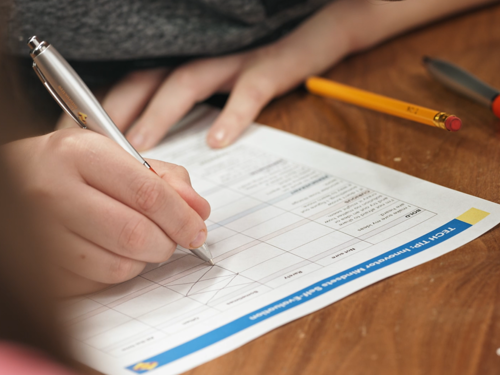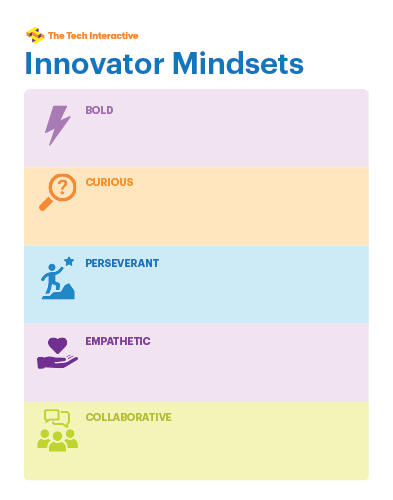Tech Tip: Innovator Mindsets
Grades: K-12

Fostering Innovator Mindsets enables learners to become creative problem-solvers.
These five mindsets build skills that extend beyond the classroom. As learners move through the Innovation Design Process, these mindsets are reinforced through practice and personal reflection.


Bold
Innovators often take risks when creating and testing.
Try new things and test out unique ideas and skills. Bravely sharing your ideas with others can lead to new and innovative solutions.
What if we tried____?

Curious
Innovators are curious about how things work.
Try a new material, ask why a device only works half the time, or investigate an untested idea. Curiosity can lead to new designs and fun discoveries.
I wonder what would happen if we ______?

Perseverant
Innovators have the perseverance to prepare for unexpected setbacks.
Celebrate learning from failures, embrace problem-solving, and overcome adversity. Persisting through these challenges can solve any problem and accomplish the impossible.
What can we learn from this failure?

Empathetic
Innovators strive to understand the feelings and challenges of others.
Prioritizing the needs of a user can lead to more inclusive design thinking, which leads to better designs for all! Designing for other's needs is a key part of engineering best practices.
How could we consider the needs of the user in our design?

Collaborative
Innovators solve challenges through teamwork and trust.
Creating diverse teams, promoting active listening, and reflecting on failures as a group are all essential to the Design Challenge Process (DCL).
How could we make all these ideas work together?
Getting Started

Strategies To Get Started
- Lead a discussion during which your learners discuss and define the mindsets for your educational setting.
- Point out when a learner practices using a mindset.
- Look for opportunities to encourage learners to practice a mindset.
- Refer to posters or visual aids that prompt learners to reinforce the mindsets during activities.
- Use journals or self-reflection tools to encourage learners to observe their use of the mindsets and growth over time.
- Resources below

Reflecting On The Mindsets
We measure what we value! Provide learners with opportunities to recognize and note growth in these areas. Weekly self-reflection in journals during a unit or session can help learners map their growth over time. You can also have them complete self-evaluations at the beginning and end of each engineering unit or school year in order to capture changes in their mindsets.
Try using our Self-Evaluation Handout in the resources section below.

Inclusive Tip
Using mindsets can help make science, technology, engineering, and mathematics (STEM) activities more inclusive. It allows space to celebrate different learners' abilities; some learners might be more curious, while others are more empathetic.

Design Challenge Learning
Innovator mindsets are centered around the Innovation Design Process, a creative problem-solving process at the heart of what we do at The Tech Interactive!
Learn more



Deep Dive
Explore detailed analysis of each innovator mindset. See tips and facilitative questions you can use to help guide your students. We also recommend activities and resources that reinforce the mindset.
Deep Dive: Bold
Why does this matter?
Learning environments that create a safe space where learners are encouraged to take risks prepare them to share their ideas in classrooms and future careers. This helps every learner develop leadership skills.
Tips for building this mindset:
- Provide structured time for learners to share their ideas and build confidence.
- Provide opportunities for creative open-ended brainstorms.
- Sometimes fun, whimsical activities lead to the most wild ideas.
Facilitative Questions:
- That’s a great idea to explore. Have you shared it with your group yet?
- Can we try writing it down or sharing it with a friend before sharing it with the group?
- What can you do when you are nervous or unsure about an idea?
- What support do you need to gain the confidence to share an idea?
Examples of learners practicing this mindset:
- Trying out an idea they aren't sure will work.
- Having the confidence to share their ideas even when they are nervous.
Resources:
![]()
Intergalactic Interview
Lesson Plan: 60 minutes
Grade Levels: 4-12
Gain confidence in sharing, interviewing, and asking questions.
![]()
Design for All: Imagining Inventions
Lesson Plan: 30 minutes
Grade Levels: 2-8
Requires bold out of the box thinking.
Deep Dive: Curious
Why does this matter?
Curiosity drives discovery. It empowers learners to wonder, question, and be open to different perspectives.
Tips for building this mindset:
- Encourage learners to ask lots of questions (Why? How? What if?).
- Use inquiry and guiding questions to start an activity.
- Have learners help you build investigative questions.
- Have learners keep a journal recording what they notice and their questions.
Facilitative Questions:
- What do you think would happen if ___?
- What do you notice? What observations do you have?
- What do you wonder? What questions do you have about this?
- If you don’t know something, how can you figure out a way to learn more?
Examples of learners practicing this mindset:
- Learners investigate the available materials to learn about their properties.
- Learners ask questions about the world around them.
- Learners try many different solutions to a problem.
Resources:
![]()
Zipline
Lesson Plan: 90 minutes
Grade 1-12
Observe and investigate a real-world phenomenon.
![]()
Connecting with Climate
Lesson Plan: 90 minutes
Grade Levels: 6-12
Explore complex environmental issues.
Deep Dive: Perseverant
Why does this matter?
Teaching learners to persevere through set-backs helps reinforce their identity as problem solvers. Reflecting helps learners understand how failure is an important part of the process.
Tips for building this mindset:
- Repeatedly remind learners that failure is part of the process!
- Give learners multiple opportunities to iterate and redesign.
- Provide learners examples of real-world situations where innovators failed and used what they learned to make something new.
- Build intrinsic motivations into the process. For example, have learners celebrate small successes and give each other shout-outs.
Facilitative Questions:
- Are there other ways you could solve the problem?
- If you can't find a solution right away, what can you do?
- What did you learn from failing? (Techniques, gained knowledge, refining skills, etc.).
Examples of learners practicing this mindset:
- Learners iterate on their devices multiple times, trying new ideas each time.
- Learners overcome frustration and keep trying.
Resources:

Perseverance: Goodr
Video: 1 min
Have you ever challenged yourself to learn a new skill that you thought was difficult or scary?

Iteration: Structure Eco
Video: 1 min
Think of a time that you had an idea that didn't work the first time. How did you make it better?
![]()
Exploring Chain Reactions
Lesson Plan: Two 60-minute sessions
Grade Levels: 2-12
Explore stored energy and energy transfer while building a series of chain reactions.
Deep Dive: Empathetic
Why does this matter?
Prioritizing the needs of a user can lead to broader interest and participation, more inclusive design thinking, and additional engineering practices. Narrative additions result in more iterations and solutions from learners.
Tips for building this mindset:
- Inclusive language practices are important, but keep in mind that not all communities want to be recognized in the same way.
- People-first language: Referring to the person before a disability. Examples include: adult with epilepsy, child with dyslexia
- Identity-first language: Referring to the disability before the person. Examples include: Deaf community, autistic person
- Try incorporating narrative elements into a Design Challenge Learning activity, like framing a challenge with a design scenario to help learners relate the problem to real-life situations.
- Challenge learners to interview real-life users or provide them with personas to reference.
Facilitative Questions:
- Who do you think would have trouble using your design? Could you make it more accessible to them
- How can you include the voices and input of others?
- How do you think others would respond to your design?
Examples of learners practicing this mindset:
- Learners consider how a passenger can be safe and comfortable riding in a device.
- Learners design devices based on the needs of a user from a persona or scenario.
Resources:
![]()
Cupcake Delivery
Lesson Plan: 60 minutes
Grade Levels: 3-5
Narrative-driven wind-powered activity.
![]()
Design for All: Project Playground
Lesson Plan: 60 minutes
Grades 3-5
Design based on a specific persona.
![]()
Design for All: Designing for Dexterity
Lesson Plan: 120 minutes
Grades 7-12
Design a device that meets the needs of a specific user.
Deep Dive: Collaboration
Why does this matter?
Collaboration is essential when working with a team. Encouraging social-emotional learning (SEL) skills like active listening prepares learners to work together on complex challenges.
Tips for building this mindset:
- Invite learners to brainstorm independently for a minute before brainstorming as a group. This will give more reserved learners time to gather their thoughts before the group starts working together.
- Have everyone share tasks, but use the roles to support leadership and accountability.
- For example, the recorder's job is to make sure someone in the group is always taking notes.
- Have learners intentionally reflect on how they included others in the process.
- Provide formal opportunities for learners to shout-out their teammates and appreciate their contributions.
Facilitative Questions:
- How can you make sure everyone on your team has a chance to contribute? (Is heard?) (Is included?)
- What if we try both ideas? Try yours on one test and ______’s on a different test?
- How can you stand up for yourself while respecting others?
Examples of learners practicing this mindset:
- A group of learners brainstorming on a design sketch together.
- Everyone in the group contributes to a list of ideas they want to test.
- Learners all take turns sharing their design.
Resources:

Blue Sky Analytics: Collaboration
Video: 30 sec
How can you work together with others to create something great?
![]()
Greywater Gadgetry
Lesson Plan: Two 60 minute sessions
Grade Levels: 6-12
Develop separate systems and then work together to combine both designs.
 Skip Navigation
Skip Navigation








